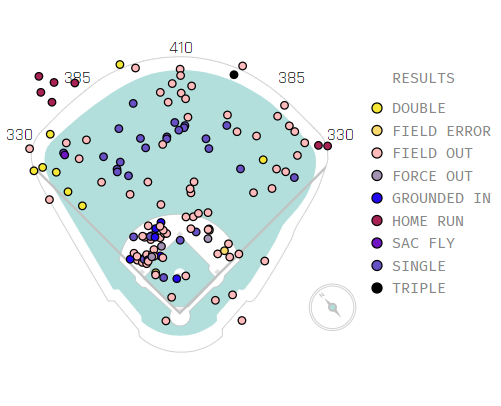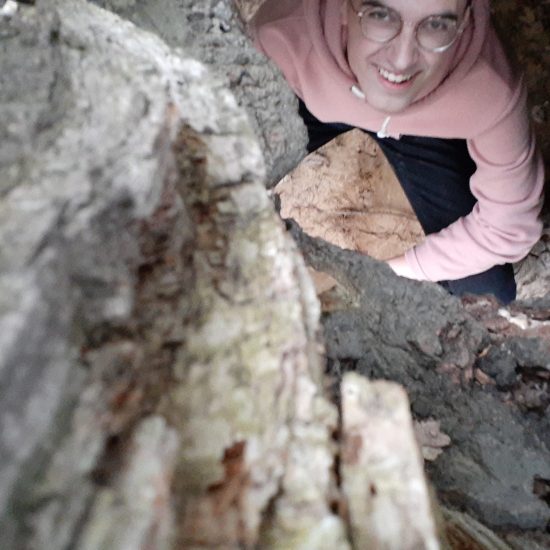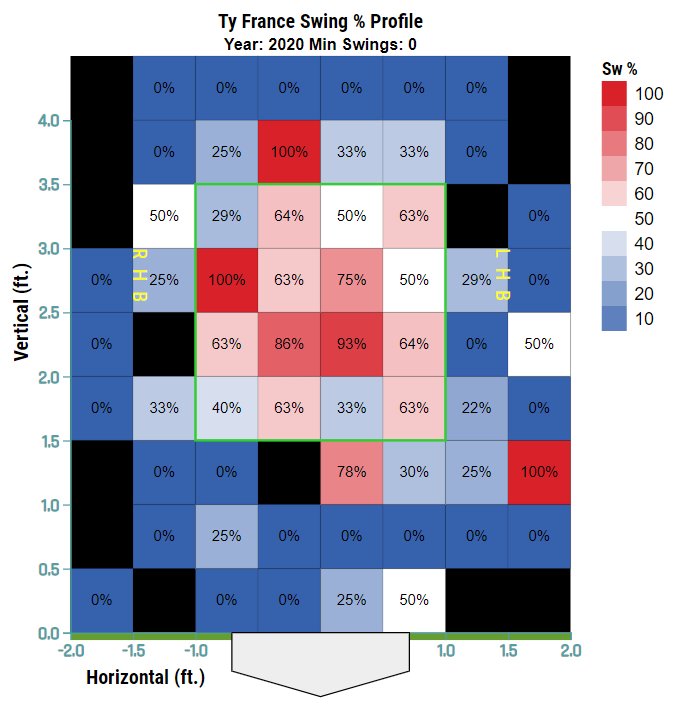Ty France is scaring a lot of Mariners fans right now. That seems like a surreal thing, doesn’t it? After all, he’s been great so far this year, albeit in limited action. He’s hitting well over .300, with decent power and plate discipline. Plus, it’s not as though he has a high bar to clear to be an upgrade in the lineup for Seattle. He’s played both 2B and DH this season, places right now occupied by Shed Long (48) and Jose Marmolejos (92), who both have subpar marks by wRC+.
Seattle Mariners fans, however, are not familiar with success. Many of their fans are comparing France to Dan Vogelbach, a player who was excellent with them for a period of a few months in early 2019 before flaming out. In the past two weeks, Vogelbach has played for three teams, and been DFA’d twice.
For all the fear that many Mariners fans will have for reading this, I do think that there are enough interesting parallels between Vogelbach and France that its helpful to compare them so that we can better understand just what the Mariners are getting themselves into with France.
Transaction History
Both France and Vogelbach were parts of deadline trades in which the Mariners were selling.
#Cubs and #Mariners nearing trade involving Dan Vogelbach and Mike Montgomery. I am told other player(s) could be included in final deal.
— Jon Morosi (@jonmorosi) July 20, 2016
Vogelbach was traded when the Cubs were the hot new team on the block. They had a special lineup, complete with one of the best young players in the game, Kris Bryant. Their farm system was full, and talks of the next dynasty were frequent. For the first time, they were legitimate World Series contenders. They had one flaw, however: Their bullpen was altogether much too thin.
And so, Daniel Vogelbach was traded to a Mariners team that had been rebuilding for 15 years, give or take. He wasn’t a great player, by any means, but he had the kind of bat that made fans excited about him, no matter how limited his glove.
We’ve acquired OF @Taytram24, INF Ty France, C @LuisTorrens13 and RHP Andrés Muñoz in exchange for C Austin Nola, RHP @DanAlt3225 and RHP Austin Adams.
Welcome to Seattle! 🙌
📰 https://t.co/UkByPaYL0p pic.twitter.com/6qMgpaTQHA
— Seattle Mariners (@Mariners) August 31, 2020
France was traded when the Padres were the new team on the block. They had a special lineup, with exciting young players like Jake Cronenworth and one of the best young players in the game, Fernando Tatis Jr. Their minor league system was still elite, ranking second in the opinion of most experts. Nobody had thought that this was quite their year yet, but they were one of the best teams in baseball, and undoubtedly a legitimate World Series contender. Their team was scary but — and stop me if you’ve heard this one before — their powerful bullpen had grown weak and the group wasn’t very deep.
And so Ty France was traded for two relievers and Austin Nola. Ty France wasn’t the headliner of this deal, but the Austins — both Nola and Adams — were better than Montgomery had ever been anyway. France wasn’t a great player, but he had performed with his bat so far that season and was the exact kind of player to be included in a Peripheral Prospects article. And he was — in fact, he was featured twice.
Defensive Ability
While with the Cubs, Vogelbach was relegated to a combination of 1B and pinch-hitting appearances. At that time, the NL did not have a DH slot, meaning that while many considered Vogelbach’s bat good enough to play most — if not every — day, he would need to flash the leather to start games. He certainly has not been good enough defensively to merit full-time starts without a special bat, which is a high bar to clear for a peripheral prospect. Over his career, Vogelbach has been worth -16.4 runs defensively.
Ty France has also been a negative defensively over the course of the year. The Mariners and Padres have tried putting him just about everywhere, but it hasn’t worked as of yet.
He’s played 3rd and 1st, probably the places that come most naturally to him and has been below average there.
The Padres tried putting France at 2B last nearly 20 times, an experiment the Mariners seem to be trying again since they traded for him. France hasn’t been horrible there, but the eye test doesn’t seem to show him having been good there (remember, fielding stats take longer to stabilize in general, and France has played 2nd all of 21 times as a major leaguer).
There’s been talk of putting France in the outfield, a position that most consider him not athletic enough to succeed at. A few Mariners fans have even suggested putting France at catcher — “It worked with Austin Nola!” — or saw France’s curveball when pitching in a blowout earlier this season and jokingly proposed France pitch full time.
Ultimately, for all the places that France could play, there’s not any place that France can play well. Since being traded to Seattle, he’s started half his games at DH. As true as it is that France is better defensively than Vogelbach, that doesn’t eliminate the fact that once a player becomes a DH, his defensive value becomes null. That doesn’t mean that France is a total zero — he’ll be able to be a utility infielder on days when players like Evan White or Kyle Seager need a breather — and freeing up the roster spot that a utility infielder would normally take up has value, but the difference between France and Vogelbach defensively is small.
What Happens When They Don’t Make Contact
In news that will shock a grand total of none of you, Daniel Vogelbach often fails to make contact. Vogelbach has had a whiff rate of over 20% for every year of his career, and in most years that number is closer to 25%. That’s not terrible by today’s standard, but it’s also not great. Fortunately, Vogelbach has two other skills that help make up for that tendency to swing and miss.
The first is that Vogelbach has a relatively good eye, in general. His chase rate so far this season is only 18.1%, one of the lowest numbers in all of baseball. League average is about about 27%. Even if a player misses a lot when they swing, if the pitch was going to be a strike anyway, then there’s no significant difference between a whiff and a called strike. But not making it easier for a pitcher can be a big deal.
The second reason that Vogelbach manages to walk a lot is his tendency to just plain not swing. For all his career, Vogelbach’s Z-Swing% has hovered around 50%, meaning that even when a pitcher throws a strike, Vogelbach tends to only swing about half the time. The league average there is about 65%. It’s probably not the best approach in general, but it does mean that Vogelbach ends up working a lot of deep counts and tiring out pitchers.
Ty France doesn’t have a carbon copy of this approach. He’s right around league average in Z-Swing% and he somehow whiffs even more often than Vogelbach does. What France does do like Vogelbach, however, is avoid swinging outside of the strike zone.
Take a look at the average swing profile for all of baseball:
Because it’s the average for all of baseball, that chart’s going to be very uniform, and make a ton of sense. Pitches within the strike zone range from a 51% swing rate all the way up to a 74% swing rate. Some pitches way out of the zone garner no swings at all.
Now take a look at France’s swing rates. Keep in mind that, since this is just one player, some of the zones, especially those not near the heart of the plate, will have a small sample size. Try to look only at the general patterns, and not hone in on any one specific box.
That’s really good! France is swinging at pitches out of the zone far less than the average player. The best part is, there’s not an area that he seems to struggle with. Sure, there’s the occasional burst of red or white outside of the zone, but they’re surrounded by groups of cool, comforting blues.
France is a bit more free-swinging than Vogey is, but both are really excellent and not swinging at balls.
What Happens When They Do Make Contact
Where the comparison between France and Vogelbach begins to fall apart is what happens when they do make contact. Vogelbach is a pull hitter, with quite a bit of power. I’d go into more depth on him, but this article isn’t primarily about Vogelbach. He’s a ton of fun, and I love him, but he’s not currently fantasy relevant. Instead, let’s look at France in a little bit more detail.
This is an overlay, showing where all France’s batted ball events end up. 
This is also good! There’s a cluster of ground balls that France has hit to shortstop and third, but not so many that teams can start moving towards any sort of shift against him. Indeed, France has only been shifted against 6% of the time this year. Once we start looking at the batted ball events that France hit into the outfield, we see almost no clusters at all. That means that France has the ability to drive the ball to all fields, another optimistic sign.
I mentioned power to all fields just now with France. That seems a tad counterintuitive. He does, after all, have only nine home runs for his entire career. And that’s partially correct. France doesn’t have crazy power — he’s only hit four balls over 110 mph for his career. What France does have, though, is a plate approach that will optimize the power he does have.
Over 60% of France’s batted ball events have been hit at over 90 mph. A 93 mph batted ball event, for example, isn’t smoked but does have a good chance of landing for a hit. That’s a really good start. Then, add on France’s launch angle numbers. France has done really well in optimizing those numbers — for his career, France is hitting balls at over 13 degrees. He doesn’t have the raw talent of some players, but his approach is nearly optimized.
Conclusion
So what does France look like going forward? He’s probably better than Vogelbach ever was. After all, France is able to contribute a little on defense, is less passive at the plate, and isn’t going to fall victim to the shift. That does not, however, mean that France is going to be an impact player. The concern I kept coming back to as I looked through these numbers was this: France’s profile seems to be nearly optimized already. He might just be what he is now.
If he doesn’t have the raw power, how is he going to improve from his current approach? How is he going to improve his plate discipline unless he figures out how to miss less when he does swing? How does he improve to the point that he’s a good defender when the reason he’s not right now is not a lack of practice but rather a lack of athleticism?
None of this means that France is a bad player. Far from it! Everything that France has done thus far seems sustainable. There is a tendency, however, for fantasy players to look at the new kid on the block when he’s performing and expect him to continue to improve. France is probably not that way. If you have league-mates who expect France to become a star, now is probably the time to move on from France. If you want to enjoy a peripheral prospect making good, then lean back, enjoy, and feel the love.
Photo by Dustin Bradford/Icon Sportswire | Adapted by Justin Paradis (@freshmeatcomm on Twitter)



